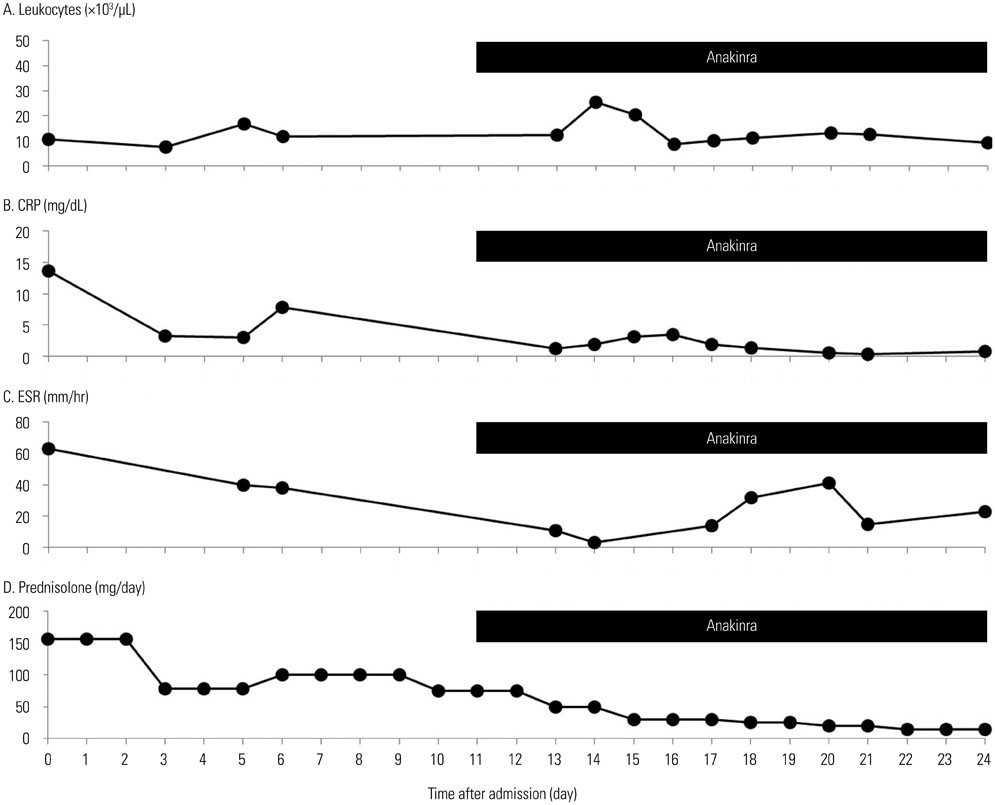Yonsei Med J.
2018 Jan;59(1):154-157. 10.3349/ymj.2018.59.1.154.
A Case of Schnitzler's Syndrome without Monoclonal Gammopathy-Associated Chronic Urticaria Treated with Anakinra
- Affiliations
-
- 1Department of Internal Medicine, Chonnam National University Medical School, Gwangju, Korea. yikoh@chonnam.ac.kr
- KMID: 2418863
- DOI: http://doi.org/10.3349/ymj.2018.59.1.154
Abstract
- Chronic urticaria may often be associated with interleukin (IL)-1-mediated autoinflammatory disease, which should be suspected if systemic inflammation signs are present. Here, we report a case of Schnitzler's syndrome without monoclonal gammopathy treated successfully with the IL-1 receptor antagonist anakinra. A 69-year-old man suffered from a pruritic urticarial rash for 12 years. It became aggravated episodically and was accompanied by high fever, arthralgia, leukocytosis, and an elevated C-reactive protein and erythrocyte sedimentation rate. The episodes each lasted for over one week. Neutrophilic and eosinophilic inflammation was found on skin biopsy. However, serum and urine electrophoresis showed no evidence of monoclonal gammopathy. The cutaneous lesions were unresponsive to various kinds of anti-histamines, systemic glucocorticoids, colchicine, cyclosporine, dapsone, and methotrexate, which were administered over a span of 3 years immediately preceding successful treatment. A dramatic response, however, was observed after a daily administration of anakinra. This observation suggests that the correct diagnosis of this case is Schnitzler's syndrome without monoclonal gammopathy. For an adult patient with refractory chronic urticaria and systemic inflammation, Schnitzler's syndrome could be considered as a possible differential diagnosis. Although the typical form of Schnitzler's syndrome exhibits the presence of monoclonal gammopathy as a diagnostic criterion, monoclonal gammopathy may be absent in an atypical form. In such a situation, an IL-1 antagonist should be effective for the management of chronic urticaria.
MeSH Terms
-
Aged
Blood Sedimentation
C-Reactive Protein/metabolism
Chronic Disease
Humans
Interleukin 1 Receptor Antagonist Protein/*therapeutic use
Leukocytes/metabolism
Male
Paraproteinemias/*complications
Schnitzler Syndrome/blood/*drug therapy
Urticaria/*complications
Interleukin 1 Receptor Antagonist Protein
C-Reactive Protein
Figure
Cited by 1 articles
-
The First Case Series of Cryopyrin-Associated Periodic Syndrome in Korea
Jong Hee Han, Yeon Jin Je, Hyun Je Yoon, Jong Gyun Ahn, Jin-Sung Lee, Jung-Won Park, Hye Jung Park
Allergy Asthma Immunol Res. 2019;11(4):583-588. doi: 10.4168/aair.2019.11.4.583.
Reference
-
1. Brodell LA, Beck LA. Differential diagnosis of chronic urticaria. Ann Allergy Asthma Immunol. 2008; 100:181–188.
Article2. Zuberbier T, Aberer W, Asero R, Bindslev-Jensen C, Brzoza Z, Canonica GW, et al. The EAACI/GA(2) LEN/EDF/WAO Guideline for the definition, classification, diagnosis, and management of urticaria: the 2013 revision and update. Allergy. 2014; 69:868–887.
Article3. Simon A, Asli B, Braun-Falco M, De Koning H, Fermand JP, Grattan C, et al. Schnitzler's syndrome: diagnosis, treatment, and follow-up. Allergy. 2013; 68:562–568.
Article4. Varella TC, Nishimura MY, Machado MC, de Moraes-Vasconcelos D, Rivitti EA. Schnitzler's syndrome without monoclonal gammopathy. Acta Derm Venereol. 2005; 85:272–273.
Article5. Urbanski M, Holfeld K, Milne A, Abbas M. Schnitzler syndrome without a monoclonal gammopathy: a case report. J Cutan Med Surg. 2016; 20:575–578.
Article6. Husak R, Nestoris S, Goerdt S, Orfanos CE. Severe course of chronic urticaria, arthralgia, fever and elevation of erythrocyte sedimentation rate: Schnitzler's syndrome without monoclonal gammopathy? Br J Dermatol. 2000; 142:581–582.
Article7. Bulua AC, Mogul DB, Aksentijevich I, Singh H, He DY, Muenz LR, et al. Efficacy of etanercept in the tumor necrosis factor receptorassociated periodic syndrome: a prospective, open-label, doseescalation study. Arthritis Rheum. 2012; 64:908–913.
Article8. Besada E, Nossent H. Dramatic response to IL1-RA treatment in longstanding multidrug resistant Schnitzler's syndrome: a case report and literature review. Clin Rheumatol. 2010; 29:567–571.
Article9. Krause K, Tsianakas A, Wagner N, Fischer J, Weller K, Metz M, et al. Efficacy and safety of canakinumab in Schnitzler syndrome: a multicenter randomized placebo-controlled study. J Allergy Clin Immunol. 2017; 139:1311–1320.
Article10. Greco E, Aita A, Galozzi P, Gava A, Sfriso P, Negm OH, et al. The novel S59P mutation in the TNFRSF1A gene identified in an adult onset TNF receptor associated periodic syndrome (TRAPS) constitutively activates NF-κB pathway. Arthritis Res Ther. 2015; 17:93.
Article11. Gerfaud-Valentin M, Jamilloux Y, Iwaz J, Séve P. Adult-onset Still's disease. Autoimmun Rev. 2014; 13:708–722.
Article12. Kim KT, Jang HJ, Lee JE, Kim MK, Yoo JJ, Lee GY, et al. Familial mediterranean fever with complete symptomatic remission during pregnancy. Intest Res. 2015; 13:287–290.
Article13. Salliot C, Dougados M, Gossec L. Risk of serious infections during rituximab, abatacept and anakinra treatments for rheumatoid arthritis: meta-analyses of randomised placebo-controlled trials. Ann Rheum Dis. 2009; 68:25–32.
Article
- Full Text Links
- Actions
-
Cited
- CITED
-
- Close
- Share
- Similar articles
-
- A Case of Monoclonal Gammopathy Associated with Aplastic Anemia: Insights into the Etiology and Points to be Considered During Diagnosis
- Monoclonal Gammopathy of Undetermined Significance Presented as a Vasculitic Neuropathy
- Diagnosis and management of monoclonal gammopathy of clinical significance
- Schnitzler Syndrome: A Case Report and Review of Literature
- A Case of Generalized Plane Xanthoma Associated with Monoclonal Gammopathy of Unknown Significance


